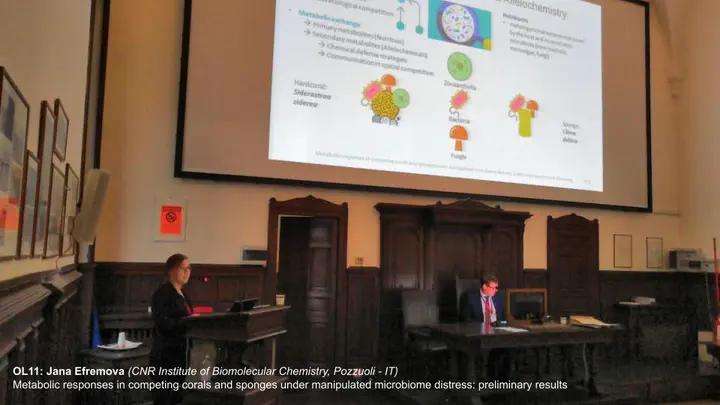Metabolic responses In competing corals and sponges under manipulated microbiome distress (Conference Talk)
 Image credit: SISBNP
Image credit: SISBNPAbstract
Symbiosis is key for survival and evolution and this is particularly true in coral reefs. The major reef-forming organisms are calcareous architects –scleractinian corals–, and their fundamental spatial competitors are bioeroding organisms –mainly boring sponges. These metazoa are strict holobionts: metaorganismal systems composed by the host and its associated microbiota (Bacteria, Archaea, microalgae, Fungi, Virus). Endosymbionts provide nutrients and bioactive metabolites that confer adaptation capabilities and ecological competence, permitting hosts to expand their biological niche and environmental resistance. Due to Global Climate Change and other impacts (e.g., ocean acidification) symbiotic partnerships can get disrupted, affecting the equilibrium of whole ecosystems. Although the exact roles of associated microbiomes are still obscure, they are known to contribute to reefs’ dynamics by promoting, on the one hand, bioconstruction, and on the other bioerosion. In a warming, acidified environment, bioerosion tends to be favored (accelerated) respect to coral growth and the stability of coral reefs declines, as is already occurring in Caribbean systems. Coral reefs are tremendously productive and biodiverse, furnishing humans with inestimable benefits, through fisheries, tourism, coastal protection and drug discovery. Associated microbial communities become key to conserve these systems, in terms of understanding nutrients cycling and communities ecological networks. To determine the significance of microbial symbiosis, we exposed the predominant coral Siderastrea siderea and the excavating sponge Cliona delitrix to combined antibiotic treatments and menthol/light manipulations. This enabled to create holobionts with modified (distressed) microbiomes (aposymbiotic), mimicking what holobionts could experience under environmental stress. We analyzed chemical parameters to elucidate metabolic phenotypic patterns related to healthy microbiome recovery, spatial competition, nutrition and acclimatization. In subsequent analysis, microbiom, and isotopic diversity data will be correlated to chemoecological information for a mechanistic understanding of mutualistic relationships in a changing world.